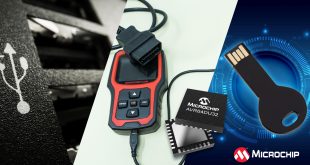 Toshiba Electronics Europe (TEE) has announced a pre-configured development board for the rapid implementation of motor control applications using its ARM Cortex-M3 family of microcontrollers. Developers can use the low-cost ‘SigmaBoard’ as a starter kit, as a reference design, or as a stand-alone solution for field-orientated control (FOC)/vector control of brushless DC (BLDC) motors with ratings to 36V and 2A.
Toshiba Electronics Europe (TEE) has announced a pre-configured development board for the rapid implementation of motor control applications using its ARM Cortex-M3 family of microcontrollers. Developers can use the low-cost ‘SigmaBoard’ as a starter kit, as a reference design, or as a stand-alone solution for field-orientated control (FOC)/vector control of brushless DC (BLDC) motors with ratings to 36V and 2A.
The SigmaBoard is a double-sided 2.5cm x 5cm PCB featuring a ‘digital side’ and an ‘analogue side’. The digital side incorporates a Toshiba TMPM373 microcontroller; a USB-to-serial interface with a default transmission rate of 115kbps; a USB connector for a host PC; an RGB LED to indicate motor phase; interfaces for U, V and W motor phase outputs; and high-side MOSFETs. The analogue side comprises: gate drivers; a current measurement circuit with a 50mO shunt resistor and amplifier for current sensing; an overcurrent comparator; and low-side MOSFETs.
The TMPM373 is a miniature, 48-pin, low-power 32-bit ARM Cortex-M3 device that will operate from a 5.0V supply with a maximum core speed of 80MHz. The MCU features an on-board vector engine, programmable motor drive functions and peripherals optimised for motor applications. On the SigmaBoard the TMPM373 is pre-configured with Toshiba’s motor control firmware. This eliminates the need for any extra software development. NANO Flash memory supports rapid programming and an OFD (Oscillation Frequency Detection) unit simplifies compliance with the IEC 60730 safety standard for appliances.
The SigmaBoard has been designed for use with Toshiba’s free MotorMind software. Running on a PC or Android system, this tool uses an intuitive graphical user interface (GUI) to simplify configuration and storage of key FOC motor control parameters. Once configured, the board is ready for standalone use and the PC can be disconnected. The minimum requirements for a fully functional system are the motor itself, a power supply for the motor and board, and an analogue speed input signal. Additional PWM speed input, fault detection and indication and tacho signals can also be connected but are not essential.
Toshiba’s SigmaBoard can also be connected to any other power boards via the relevant pins on the PCB. This allows engineers to use the same firmware and digital elements to develop systems for controlling larger motors or addressing different application requirements.
 CIE Components in Electronics
CIE Components in Electronics



